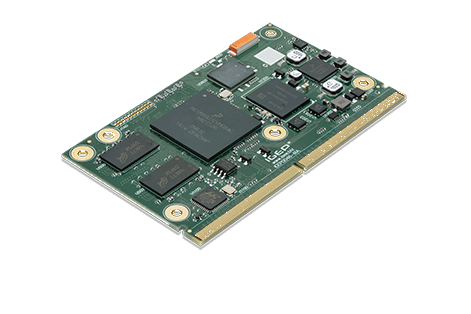Difference between revisions of "What can I do with IGEP SMARC iMX6"
From IGEP - ISEE Wiki
| Line 108: | Line 108: | ||
== Boot from eMMC == | == Boot from eMMC == | ||
| − | + | '''under construction''' | |
| − | |||
== How to use EEPROM == | == How to use EEPROM == | ||
Revision as of 13:31, 26 May 2016
| |
| |||||||||
Overview
This is the 2/3 chapter of the Getting Started with IGEP SMARC iMX6 Tutorial Guide.
In this second chapter, we will learn some basics tasks. Upon completion, you will be ready to continue with chapter 3/3 that explains more advanced tasks.
Contents
[hide]
What can I do
You must logged in the board.
Handle the GPIO-LEDS
The board has two user bicolor (green/red) leds available that can be controlled. In its simplest form, you can control of LEDs from userspace. LEDs appear in /sys/class/leds/igep and you can turn on and off with following commands:
echo 1 > /sys/class/leds/igep\:red\:led1/brightness echo 1 > /sys/class/leds/igep\:red\:led0/brightness echo 0 > /sys/class/leds/igep\:red\:led1/brightness echo 0 > /sys/class/leds/igep\:red\:led0/brightness
echo 1 > /sys/class/leds/igep\:green\:led1/brightness echo 1 > /sys/class/leds/igep\:green\:led0/brightness echo 0 > /sys/class/leds/igep\:green\:led1/brightness echo 0 > /sys/class/leds/igep\:green\:led0/brightness
If you want to trigger the leds you can enable this mode and select the trigger source (none by default) to: mmc0, mmc1, timer, heartbeat and default-on.
To enable any of this modes you just have to change a parameter in the directory of the led you want to control. You can see all the possibilities using the instruction 'cat':
cat /sys/class/leds/igep\:red\:led0/trigger [none] mmc0 mmc1 timer heartbeat default-on
In the example above, we have checked the status of the trigger in led red\led0. Mode 'none' is selected.
To change it, for example, to the timer mode you can use 'echo':
echo timer > /sys/class/leds/igep\:red\:led0/trigger
In this case, we have set the trigger to the 'timer' mode. Now you can set the time for what the led is ON and the time it is OFF using:
echo 250 > /sys/class/leds/igep\:red\:led0/delay_on echo 750 > /sys/class/leds/igep\:red\:led0/delay_off
Now the selected led is configured with a timer consisting of 250 miliseconds ON and 750 miliseconds OFF.
The base has two user (red/blue) leds available that can be controlled. Can't use them in the same time. In its simplest form, you can control of LEDs from userspace. LEDs appear in /sys/class/leds/base and you can turn on and off with following commands:
echo 1 > /sys/class/leds/base\:blue\:led0/brightness echo 1 > /sys/class/leds/base\:red\:led0/brightness echo 0 > /sys/class/leds/base\:blue\:led0/brightness echo 0 > /sys/class/leds/base\:red\:led0/brightness
How to use UART (RS485)
under construction
CAN BUS
under construction
Audio
under construction
Install firmware in eMMC
In order to access the eMMC and be capable of flashing it, we can make use of the UMS (U-boot Mass Storage gadget).
- Plug a microUSB to USB cable from J602 USB OTG connector to your computer. Boot the board from the microSD card and abort autoboot pressing a key when U-boot is waiting before loading the kernel. Then, start UMS with the following command:
ums 0 mmc 1
Where 0 is the USB device number 0 (USB OTG, in this case), mmc is the kind of storage device to be read (mmc or sata), and 1 is the storage device number, in this case mmc1 (onboard eMMC).
- If correctly done, U-boot should print something similar to the next line, and a mass storage device should appear in your computer.
UMS: disk start sector: 0x0, count: 0xe90000
- You can now backup its contents, as well as format it, make partitions, or use igep-media-create to flash it with an image; all straight from the computer.
Boot from SATA
under construction
Boot from eMMC
under construction
How to use EEPROM
EEPROM can be read and write via /sys/devices/soc0/soc.0/2100000.aips-bus/21a8000.i2c/i2c-2/2-0050/eeprom:
- Write EEPROM:
echo "data" > /sys/devices/soc0/soc.0/2100000.aips-bus/21a8000.i2c/i2c-2/2-0050/eeprom
- Read EEPROM:
cat /sys/devices/soc0/soc.0/2100000.aips-bus/21a8000.i2c/i2c-2/2-0050/eeprom
- Following output is expected on console:
data
d
drate=115200boot_fdt=trybootcmd=echo Try first mmc (SD)...; mmc dev ${mmcdev};if mmc rescan; then if run loadbootscript; then run bootscript; else if run loadimage; then run mmcboot; fi; fi; fi; echo Try a
d
drate=115200boot_fdt=trybootcmd=echo Try first mmc (SD)...; mmc dev ${mmcdev};if mmc rescan; then if run loadbootscript; then run bootscript; else if run loadimage; then run mmcboot; fi; fi; fi; echo Try a
d
drate=115200boot_fdt=trybootcmd=echo Try first mmc (SD)...; mmc dev ${mmcdev};if mmc rescan; then if run loadbootscript; then run bootscript; else if run loadimage; then run mmcboot; fi; fi; fi; echo Try a
d
When ever you think you want to stop recording just press CTRL+C
How to use SPI NOR
Can be read and write files into SPI NOR:
- Create a directory:
mkdir Documents
- Create a file in the directory:
cd Documents/ touch prova
- Write something in the file:
echo "data" > prova
- Write the file into SPI NOR:
mtd_debug write /dev/mtd0 0 1 ./Documents/prova
- Read the file:
mtd_debug read /dev/mtd0 0 1 prova
IO expansion
under construction
wifi
under construction
HDMI resolution
under construction
modem USB
under construction
You have successfully completed this chapter of the guide.
| |

|
If you have any question, don't ask to ask at the IGEP Community Forum or the IGEP Community Chat | 
|



